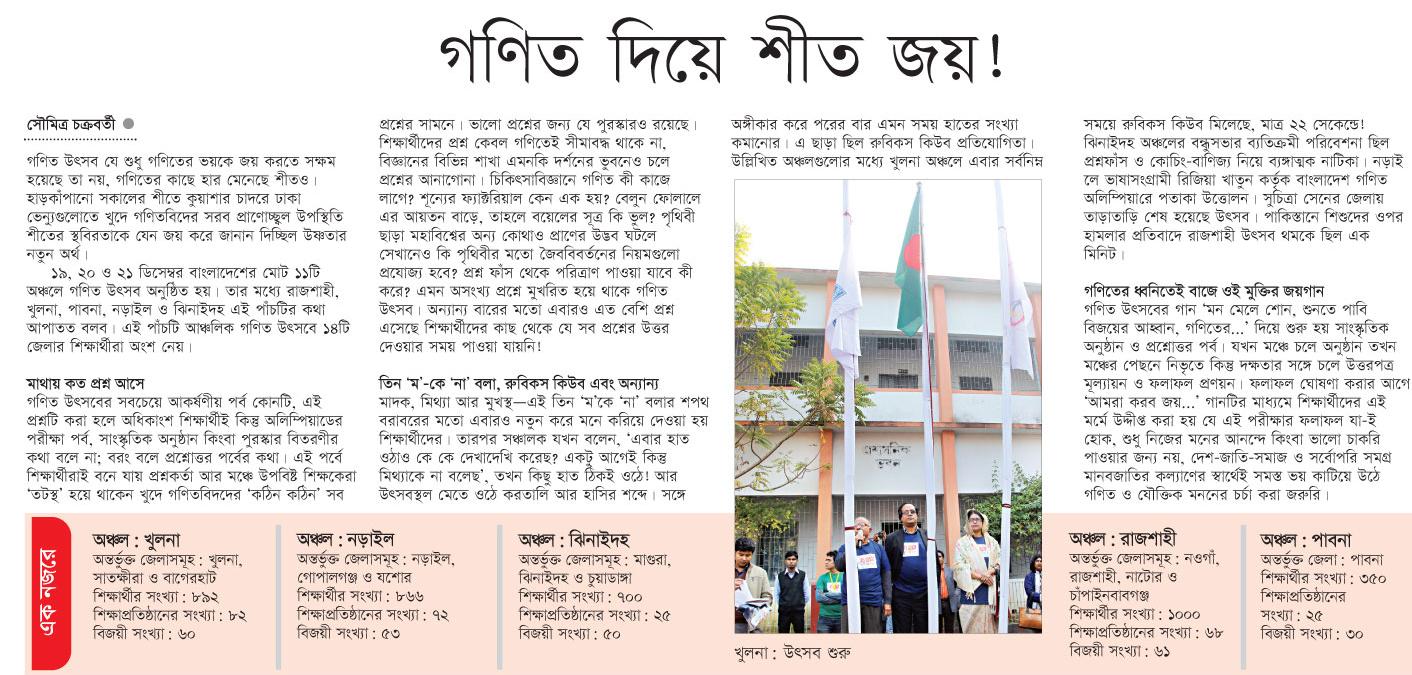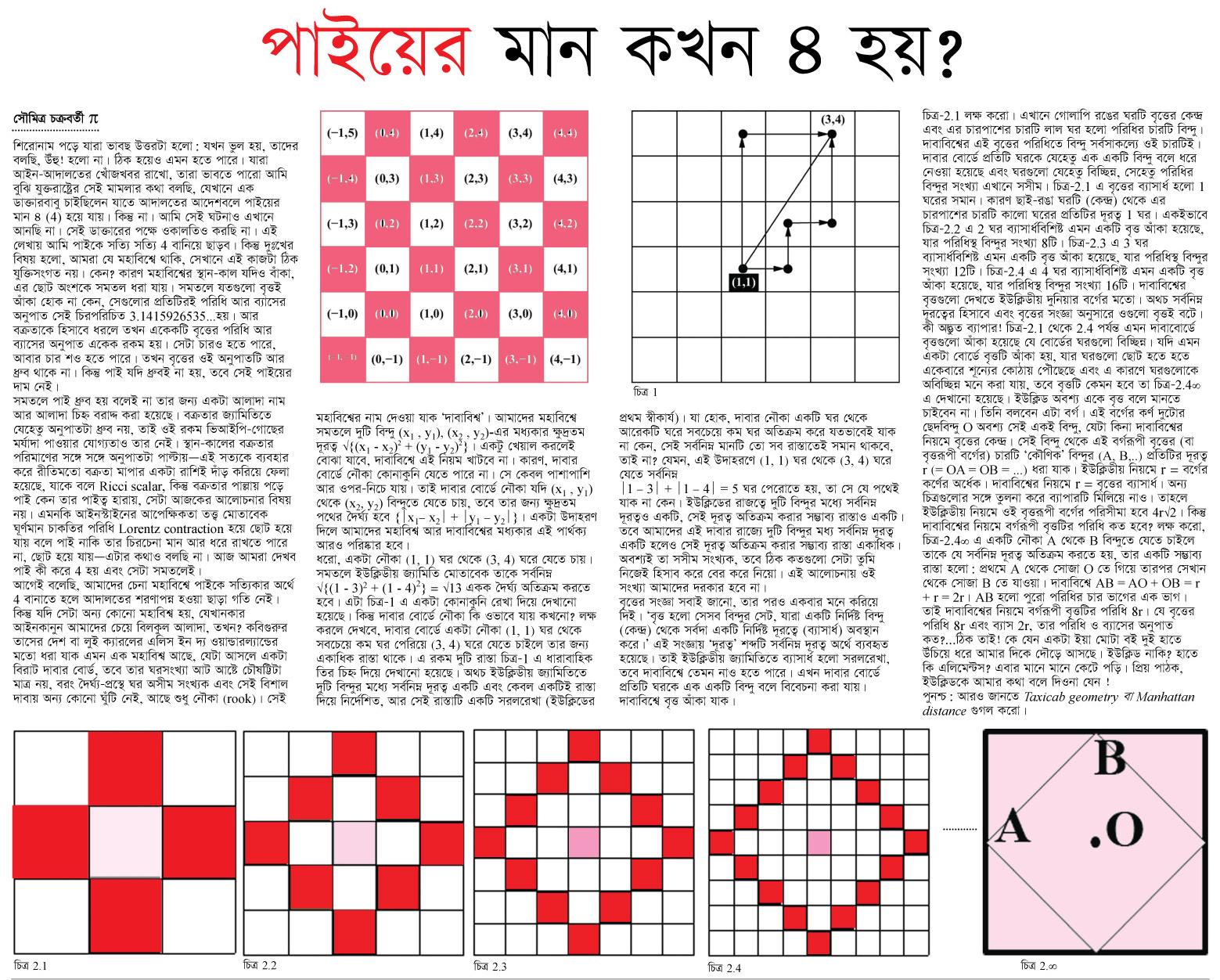সংশোধনী: যুক্তরাষ্ট্রের ক্লে ম্যাথমেটিক্স ইন্সটিটিউট, Millenium Problem শিরোনামে যে সাতটি সমস্যা সমাধানের জন্য (তার মধ্যে একটি ইতোমধ্যে সমাধান করা হয়ে গেছে) এক মিলিয়ন ডলার করে পুরষ্কার ঘোষণা করেছে, গোল্ডবাখ অনুমান তার মধ্যে নেই। তবে Apostolos Doxiadis রচিত Uncle Petros and Goldbach’s Conjecture নামে একটি উপন্যাসের প্রকাশনা সংস্থাদ্বয়, Bloomsbury Publishing (যুক্তরাষ্ট্র) এবং Faber and Faber Limited (যুক্তরাজ্য), এই গোল্ডবাখ অনুমান প্রমান করার জন্য এক মিলিয়ন ডলার পুরষ্কার ঘোষণা করে। যদিও মিলেনিয়াম প্রবলেমগুলোর সমাধানের জন্য কোনো সময়সীমা নির্দিষ্ট করে দেওয়া নেই, গোল্ডবাখ অনুমানের প্রমান জমা দেওয়ার জন্য বেঁধে দেওয়া সময় ছিল 2002 সাল। সেই পুরষ্কারের কোনো দাবিদার জোটেনি।
All posts by mitttir
বিজ্ঞান চিন্তা [বিজ্ঞান মাসিক]: মার্চ ২০১৭
National Conference on Health Professions Education 2014
Download conference proceedings
This paper was presented by me at the National Conference on Health Professions Education in Bangladesh on June 26, 2014 at Institute of Public Health (IPH) Conference Hall, Mohakhali, Dhaka, Bangladesh. The conference was organized by Association of Medical Education (AME), Bangladesh and Center for Medical Education (CME); and supported by World Health Organization (WHO).
Sub Topic – Pedagogy
Title – Applying Euclid’s Idea in Teaching-Learning of Biological Sciences: A Proposal
Presenter – Saumitra Chakravarty, Resident, Department of Pathology, Bangabandhu Sheikh Mujib Medical University.
Abstract
In general, we tend to learn geometry and biology in radically different ways. The former is always rigorous, linearly structured and quite straightforward in its deductive reasoning. On the other hand, the latter is sometimes vaguely expressed, non-linear and mostly shadowy in terms of reasoning techniques. But a closer look reveals that these differences are only apparent. The logical structure used by Euclid to organize geometric data into his famous compilation ‘Elements’ can be helpful when organizing biological data as well. We implicitly use his so-called ‘axiomatic hierarchical’ design in teaching-learning of biological sciences. My proposal is to make this implicit approach explicit, so that the students can get an essence of logical rigor while studying biological sciences. This would promote a holistic and integrated understanding, which is essential in building their ability to effectively analyze the available information so that they are able to precisely identify gaps and synthesize knowledge from it. A few words of caution and clarification are essential though. This axiomatic hierarchical design is not equally applicable in all areas of biological sciences, especially where there is an abundance of feedback loops, making linear approximation of a non-linear phenomenon quite impracticable. But then again, no model is accurate but some are useful. Meaningful research is warranted on the current proposal before making any conclusive remark.
National Conference on Health Professions Education 2015
This paper was presented by me at the National Conference on Health Professions Education in Bangladesh on November 28, 2015 at Institute of Public Health (IPH) Conference Hall, Mohakhali, Dhaka, Bangladesh. The conference was organized by Association of Medical Education (AME), Bangladesh and Center for Medical Education (CME); and supported by World Health Organization (WHO).
Sub Topic – Educational Management
Title – Educational Mismanagement: A Subjective Reflection
Presenter – Saumitra Chakravarty, Resident, Department of Pathology, Bangabandhu Sheikh Mujib Medical University.
Abstract
During my tenure as a guest teacher for a period of about a year in a Government-run institute of health technology, a training facility for would-be health technologists, I noticed some irregularities which were difficult for me to ignore. Mostly those were regarding the educational management system of the institute as well as of the education system as a whole. Over time, the mismanagement grew into an organized ecosystem of numerous agents including local and national political influences, bureaucratic incompetence, ergonomic incompatibilities, unacceptable compromise of quality over quantity, incoherent curriculum, paperbound regulations, socio-cultural inertia and so on. Therefore, in my opinion, the mismanagement might not be corrected slowly or gradually or compartmentally, since trying to correct one or few aspects at a time would soon be counteracted automatically through negative feedback loops by other factors acting as interdependent links in the ecosystem, ultimately establishing a ‘homeostasis’ per se. Such scenarios may be extrapolated to other such educational institutes of the country as well. Alleviation of the situation may require careful and comprehensive analysis of the crisis followed by a planned, coordinated, transformative, multi-faceted and parallel approach based on the analysis that should warrant some drastic and somewhat revolutionary imperatives.
Practical Pathology 2017: Vol.1, No.1
Click to download full article
Click to visit the journal website
NB: This report was presented by Dr. Saumitra Chakravarty in the 4th Conference of the SAARC Academy of Cytopathology & Histopathology held in BP Koirala Institute of Health Sciences, Nepal during 16-18 September 2016. It won the honor of one of the three best scientific presentations at the conference.
গণিত উৎসব ২০১৫ [দৈনিক প্রথম আলোর ক্রোড়পত্র]: ১৯ জানুয়ারি ২০১৫
গণিত ইশকুল [দৈনিক প্রথম আলোর গণিত পাতা]: ১৫ জানুয়ারি ২০১২
গণিত ইশকুল [দৈনিক প্রথম আলোর গণিত পাতা]: ১৮ মার্চ ২০১২
Following is the original printed version of the article which contains many typos. Click here to download the corrected version. [NB: You will not be able to read the pdf on your browser or on phone. Please download and read it offline on a PC. This is because it is typed in SutonnyMJ (ANSI) font and you will need this font installed in order to read the article.]
গণিত ইশকুল [দৈনিক প্রথম আলোর গণিত পাতা]: ২৭ মে ২০১২
গণিত ইশকুল [দৈনিক প্রথম আলোর গণিত পাতা]: ৬ অক্টোবর ২০১২
This article is later published as a part of a book (Sombhoboto, pages 127-130) by the same author. Python code is used to simulate the number of heads and tails as tabulated in the article.








